四年级英语上册全册教案新版广州版
广州版四年级英语上册教案(精选五篇)
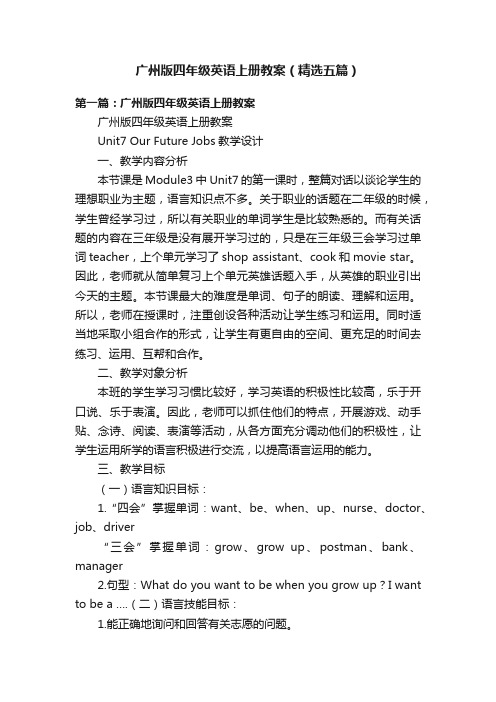
广州版四年级英语上册教案(精选五篇)第一篇:广州版四年级英语上册教案广州版四年级英语上册教案Unit7 Our Future Jobs教学设计一、教学内容分析本节课是Module3中Unit7的第一课时,整篇对话以谈论学生的理想职业为主题,语言知识点不多。
关于职业的话题在二年级的时候,学生曾经学习过,所以有关职业的单词学生是比较熟悉的。
而有关话题的内容在三年级是没有展开学习过的,只是在三年级三会学习过单词teacher,上个单元学习了shop assistant、cook和movie star。
因此,老师就从简单复习上个单元英雄话题入手,从英雄的职业引出今天的主题。
本节课最大的难度是单词、句子的朗读、理解和运用。
所以,老师在授课时,注重创设各种活动让学生练习和运用。
同时适当地采取小组合作的形式,让学生有更自由的空间、更充足的时间去练习、运用、互帮和合作。
二、教学对象分析本班的学生学习习惯比较好,学习英语的积极性比较高,乐于开口说、乐于表演。
因此,老师可以抓住他们的特点,开展游戏、动手贴、念诗、阅读、表演等活动,从各方面充分调动他们的积极性,让学生运用所学的语言积极进行交流,以提高语言运用的能力。
三、教学目标(一)语言知识目标:1.“四会”掌握单词:want、be、when、up、nurse、doctor、job、driver“三会”掌握单词:grow、grow up、postman、bank、manager2.句型:What do you want to be when you grow up?I want to be a ….(二)语言技能目标:1.能正确地询问和回答有关志愿的问题。
2.能理解课文意思,用正确的语音语调流利地朗读课文并表演课文。
(三)学习策略目标通过课文的学习,提高学生自主学习的能力。
同时,通过小组活动提高学生与人交流合作的能力。
(四)情感态度目标1.通过各种活动让学生体现学习的乐趣,从而增强英语学习的信心。
最新广州版小学英语四年级上册精品教案全册
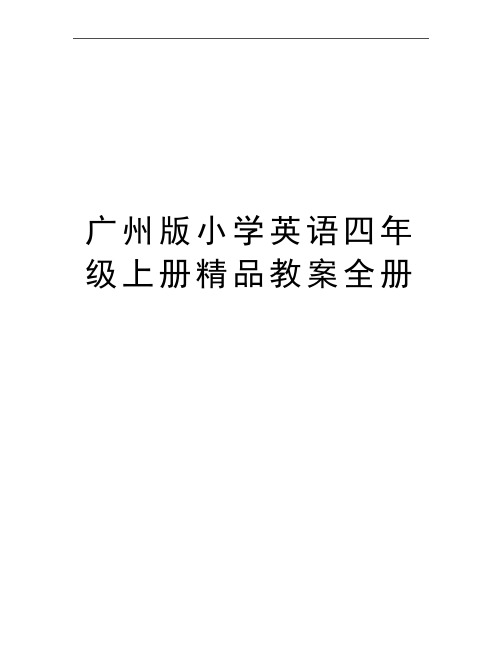
广州版小学英语四年级上册精品教案全册广州版小学英语四年级上册精品教案全册Module 1 ClothesUnit 1 Buying ClothesUnit 2 Different ClothesUnit 3 DevelopmentModule 2 PeopleUnit 4 FriendsUnit 6 DevelopmentUnit 5 Our Heroes And HeroinesModule 3 OccupationsUnit 7 Our Future JobsUnit 8 My family members’ jobsUnit 9 DevelopmentModule 4 People Who Help UsUnit 10 The New NeighboursUnit 11 They Can Help UsModule 5 TimeUnit 13 Our ArrangementUnit 14 Time to go to schoolUnit 15 DevelopmentModule 6 Days of the weekU16 Games we playRevision ⅠⅡⅢLong-Term ObjectivesSuccess with English aims to help pupils to achieve the following objectives: ●To enjoy learning English;●To be motivated to learn English;●To become independent learners and users of English;●To want to be able to continue learning English after the course;●To become accurate users of English;●To become fluent users of English;●To become appropriate users of English;●To become effective users of English;●To become effective listeners of English;●To become effective speakers of English;To become effective writers of English.Module 1 ClothesI. Objectives(目标)1. Language skill (Listening speaking reading writing)(1) know about clothes in English(2) can talk about clothes and ask the price of the clothes I want to buy.2. Language knowledge(1) Vocabulary:4 skills: shirt, blouse, dress, skirt, coat, pair, a pair of …., shoe, shorts, shop, can, help,I’d like to buy… much, h ow much, yuan, forth, them, twenty, thirty, fifty,eighty, hundred, T-shirt, sock, pound, whose3 skills: clothes, jacket, sweater, trousers, jeans, assistant, shop assistant, take, I’ll takeit, sport, sport shoe, sir, bye, madamDrills(2) * Can I help you, sir / madam?* I’d like to buy a pair of shoes.* How much is the T-shirt?* It’s twenty yuan.* How much are the trousers?They’re forty pounds.* Whose is the coat?It’s John’s.* Whose are the long socks?They’re my sister’s.(3) sub-topic:Unit 1: Buying clothesUnit 2: Different clothesUnit 3: Development3. Affect(1) To give pupils chances to share their knowledge.(2) To increase pupils’ confidence & self-esteem(3) To provide challenges(4) To have fun(5) To develop cultureal awareness(6) To open the pupils’ minds(7) To promote imagination4. Learning Strategy(1) Cognitive strategy(2) Regulating strategy(3) Communicative resource strategy5. Cultural Consciousness(1) The Eskimo woman wears her fur coat in winter in order to keep warm.(2) The Japanese woman wears her kimono at ceremonies because it’s traditional.(3) The African woman wears her grass skirt when she is dancing. This is because it’straditional and it keeps her cool.II. focal points:1.Can I help you sir / madam?2.I’d like to….3.How much is / are…?It’s / They’re…4.Whose is / are…?III. Difficult pointsage of “a pair of ….”2.Practice in numerals.IV. Schedule: 8 long-periodsV. Materials: Textbook, Activity book, Tapes, Teacher’s book, word cards.Unit 1 Buying ClothesI. Subjects1. vocabulary:can, help, buy, much, yuan, dress (4 skills)shop assistant, clothes, take (3 skills)2. Can I help you? I’d like to buy….How much is it? It’s….3. Culture: “yuan”——外来语,单复同形II. Focal and difficult pointsCan I help you? I’d like to….How much is it? It’s…I’ll take itIII. Processes1. Leading inA. Review numeralsTen, twenty… ninety →ninety yuan (show) “yuan” 外来语,单复同形 B. P1 T: Guess! Which one is worth 90 yuan?Yes, the dress. (教dress pl dresses)2. PresentationA. P2 T: Now, the woman is shopping at the shop.→ T分饰两角,重复对话两次配合动作让生了解对话。
广州版英语四年级上册教案全册

广州版英语四年级上册教案全册Module 1 ClothesUnit 1 Buying ClothesUnit 2 Different ClothesUnit 3 DevelopmentModule 2 PeopleUnit 4 FriendsUnit 6 DevelopmentUnit 5 Our Heroes And HeroinesModule 3 OccupationsUnit 7 Our Future JobsUnit 8 My family members’ jobsUnit 9 DevelopmentModule 4 People Who Help UsUnit 10 The New NeighboursUnit 11 They Can Help UsModule 5 TimeUnit 13 Our ArrangementUnit 14 Time to go to schoolUnit 15 DevelopmentModule 6 Days of the weekU16 Games we playRevision ⅠⅡⅢLong-Term ObjectivesSuccess with English aims to help pupils to achieve the following objectives:●To enjoy learning English;●To be motivated to learn English;●dent learners and users of English;●To want to be able to continue learning English after the course;●●●●●●●Module 1 ClothesI. Objectives(目标)1. Language skill (Listening speaking reading writing)(1) know about clothes in English(2) can talk about clothes and ask the price of the clothes I want to buy.2. Language knowledge(1) Vocabulary:4 skills: shirt, blouse, dress, skirt, coat, pair, a pair of …., shoe, shorts, shop, can, help, I’d liketo buy… much, how much, yuan, forth, them, twenty, thirty, fifty, eighty, hundred,T-shirt, sock, pound, whose3 skills: clothes, jacket, sweater, trousers, jeans, assistant, shop assistant, take, I’ll take it, sport,sport shoe, sir, bye, madamDrills(2) * Can I help you, sir / madam?* I’d like to buy a pair of shoes.* How much is the T-shirt?* It’s twenty yuan.* How much are the trousers?They’re forty pounds.* Whose is the coat?It’s John’s.* Whose are the long socks?They’re my sister’s.(3) sub-topic:Unit 1: Buying clothesUnit 2: Different clothesUnit 3: Development3. Affect(1) To give pupils chances to share their knowledge.(2) To increase pupils’ confidence & self-esteem(3) To provide challenges(4) To have fun(5) To develop cultureal awareness(6) To open the pupils’ minds(7) To promote imagination4. Learning Strategy(1) Cognitive strategy(2) Regulating strategy5. Cultural Consciousness(1) The Eskimo woman wears her fur coat in winter in order to keep warm.(2) The Japanese w oman wears her kimono at ceremonies because it’s traditional.(3) The African woman wears her grass skirt when she is dancing. This is because it’straditional and it keeps her cool.II. focal points:1.Can I help you sir / madam?2.I’d like to….3.How much is / are…?It’s / They’re…4.Whose is / are…?III. Difficult pointsage of “a pair of ….”2.Practice in numerals.IV. Schedule: 8 long-periodsV. Materials: Textbook, Activity book, Tapes, Teacher’s book, word cards.Unit 1 Buying ClothesI. Subjects1. vocabulary:can, help, buy, much, yuan, dress (4 skills)shop assistant, clothes, take (3 skills)2. Can I help you? I’d like to buy….How much is it? It’s….3. Culture: “yuan”——外来语,单复同形II. Focal and difficult pointsCan I help you? I’d like to….How much is it? It’s…I’ll take itIII. Processes1. Leading inA. Review numeralsTen, twenty… ninety →ninety yuan (show) “yuan” 外来语,单复同形B. P1T: Guess! Which one is worth 90 yuan?Yes, the dress. (教dress pl dresses)2. PresentationA. P2 T: Now, the woman is shopping at the shop.→T分饰两角,重复对话两次配合动作让生了解对话。
广州版英语四年级上册全册教案备课

广州版英语四年级上册全册教案备课Module 1 ClothesI. Objectives(目标)1. Language skill (Listening speaking reading writing)(1) know about clothes in English(2) can talk about clothes and ask the price of the clothes I want to buy.2. Language knowledge(1) Vocabulary:4 skills: shirt, blouse, dress, skirt, coat, pair, a pair of …., shoe, shorts, shop, can, help, I‘d like tobuy… much, how much, yuan, forth, them, twenty, thirty, fifty, eighty, hundred, T-shirt,sock, pound, whose3 skills: clothes, jacket, swea ter, trousers, jeans, assistant, shop assistant, take, I‘ll take it, sport,sport shoe, sir, bye, madamDrills(2) * Can I help you, sir / madam?* I‘d like to buy a pair of shoes.* How much is the T-shirt?* It‘s twenty yuan.* How much are the trousers?They‘re forty pounds.* Whose is the coat?It‘s John‘s.* Whose are the long socks?They‘re my sister‘s.(3) sub-topic:Unit 1: Buying clothesUnit 2: Different clothesUnit 3: Development3. Affect(1) To give pupils chances to share their knowledge.(2) To increase pupils‘ confidence & self-esteem(3) To provide challenges(4) To have fun(5) To develop cultureal awareness(6) To open the pupils‘ minds(7) To promote imagination4. Learning Strategy(1) Cognitive strategy(2) Regulating strategy(3) Communicative resource strategy5. Cultural Consciousness(1) The Eskimo woman wears her fur coat in winter in order to keep warm.(2) The Japanese woman wears her kimono at ceremonies because it‘s traditional.(3) The African woman wears her grass skirt when she is dancing. This is because it‘s traditionaland it keeps her cool.II. focal points:1.Can I help you sir / madam?2.I‘d like to….3.How much is / are…?It‘s / They‘re…4.Whose is / are…?III. Difficult points1.U sage of ―a pair of ….‖2.Practice in numerals.IV. Schedule: 8 long-periodsV. Materials: Textbook, Activity book, Tapes, Teacher‘s book, word cards.Unit 1 Buying ClothesI. Subjects1. vocabulary:can, help, buy, much, yuan, dress (4 skills)shop assistant, clothes, take (3 skills)2. Can I help you? I‘d like to buy….How much is it? It‘s….3. Culture: ―yuan‖——外来语,单复同形II. Focal and difficult pointsCan I help you? I‘d like to….How much is it? It‘s…I‘ll take itIII. Processes1. Leading inA. Review numeralsTen, twenty… ninety →ninety yuan (show) ―yuan‖ 外来语,单复同形B. P1T: Guess! Which one is worth 90 yuan?Yes, the dress. (教dress pl dresses)2. PresentationA. P2 T: Now, the woman is shopping at the shop.→T分饰两角,重复对话两次配合动作让生了解对话。
最新广州版小学四年级上册英语教案(全)

最新广州版小学四年级上册英语教案含练习设计目录Unit 1 What‘s in your room? (3)Unit 2 They are the windows (11)Unit3 Welcome to my house (17)Unit4 I live in a big house (22)Unit 5 Let me show you our new school (29)Unit6 How many classrooms are there in your school? (30)Unit 7 How many stars does each group have? (33)Unit 8 I like English best (36)Unit 9 Look at this T-shirt (38)Unit10 Can I help you? (45)Unit 11 I want to be a paniter (52)Unit12 What‘ s your father‘s job? (57)Unit 1 What’s in your room?1、词汇Want / next to.../ between2、重点句型1)询问某物里面有什么的句型----What‘s in...?句型结构:What‘s in + 其他?重点解析:此句型是由what引导的特殊疑问句。
疑问词what意为―什么‖,介词in 意为―在...里面‖。
答语为―There is/are + + in + 其他.‖,也可以直接回答物品名称。
例如:What‘s in your room?---There is a bed, a desk and a chair in my room.What‘s in your bag? ---There are some books and a pen.2)问颜色----What colour...?句型结构:What colour is/are + 物品?例如:What colour is your computer? ---It‘s pink.What colour are they? ---They are green.3、方位介词On表示―在...上面‖。
【广州市】新版外研版四年级英语上册教案全册
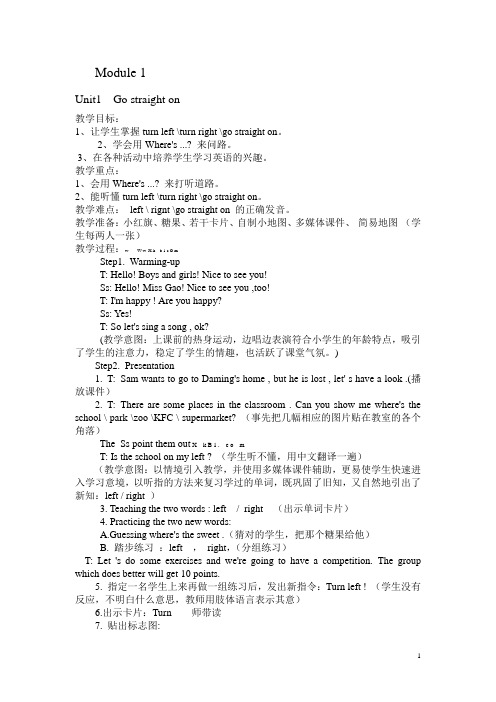
Module 1Unit1 Go straight on教学目标:1、让学生掌握turn left \turn right \go straight on。
2、学会用Where's ...? 来问路。
3、在各种活动中培养学生学习英语的兴趣。
教学重点:1、会用Where's ...? 来打听道路。
2、能听懂turn left \turn right \go straight on。
教学难点:left \ rignt \go straight on 的正确发音。
教学准备:小红旗、糖果、若干卡片、自制小地图、多媒体课件、简易地图(学生每两人一张)教学过程:w W w .X k b 1.c O mStep1. Warming-upT: Hello! Boys and girls! Nice to see you!Ss: Hello! Miss Gao! Nice to see you ,too!T: I'm happy ! Are you happy?Ss: Yes!T: So let's sing a song , ok?(教学意图:上课前的热身运动,边唱边表演符合小学生的年龄特点,吸引了学生的注意力,稳定了学生的情趣,也活跃了课堂气氛。
)Step2. Presentation1. T: Sam wants to go to Daming's home , but he is lost , let' s have a look .(播放课件)2. T: There are some places in the classroom . Can you show me where's the school \ park \zoo \KFC \ supermarket? (事先把几幅相应的图片贴在教室的各个角落)The Ss point them out X k B 1 . c o mT: Is the school on my left ? (学生听不懂,用中文翻译一遍)(教学意图:以情境引入教学,并使用多媒体课件辅助,更易使学生快速进入学习意境,以听指的方法来复习学过的单词,既巩固了旧知,又自然地引出了新知:left / right )3. Teaching the two words : left / right (出示单词卡片)4. Practicing the two new words:A.Guessing where's the sweet .(猜对的学生,把那个糖果给他)B. 踏步练习:left ,right,(分组练习)T: Let 's do some exercises and we're going to have a competition. The group which does better will get 10 points.5. 指定一名学生上来再做一组练习后,发出新指令:Turn left ! (学生没有反应,不明白什么意思,教师用肢体语言表示其意)6.出示卡片:Turn 师带读7. 贴出标志图:Turn left Turn right8 . Competition.规则:每组选一名同学上台,听教师指令,做左转、右转,做错的同学淘汰下去,最后一名站在台上的同学就是胜利者,可为自己小组加10分。
广州版小学英语四年级上册精品教案全册

广州版小学英语四年级上册精品教案全册Module 1 ClothesUnit 1 Buying ClothesUnit 2 Different ClothesUnit 3 DevelopmentModule 2 PeopleUnit 4 FriendsUnit 6 DevelopmentUnit 5 Our Heroes And HeroinesModule 3 OccupationsUnit 7 Our Future JobsUnit 8 My family members’ jobsUnit 9 DevelopmentModule 4 People Who Help UsUnit 10 The New NeighboursUnit 11 They Can Help UsModule 5 TimeUnit 13 Our ArrangementUnit 14 Time to go to schoolUnit 15 DevelopmentModule 6 Days of the weekU16 Games we playRevision ⅠⅡⅢLong-Term ObjectivesSuccess with English aims to help pupils to achieve the following objectives:●To enjoy learning English;●To be motivated to learn English;●To become independent learners and users of English;●To want to be able to continue learning English after the course;●To become accurate users of English;●To become fluent users of English;●To become appropriate users of English;●To become effective users of English;●To become effective listeners of English;●To become effective speakers of English;●To become effective writers of English.Module 1 ClothesI. Objectives(目标)1. Language skill (Listening speaking reading writing)(1) know about clothes in English(2) can talk about clothes and ask the price of the clothes I want to buy.2. Language knowledge(1) Vocabulary:4 skills: shirt, blouse, dress, skirt, coat, pair, a pair of …., shoe, shorts,shop, can, help, I’d like to buy… much, how mu ch, yuan,forth, them, twenty, thirty, fifty, eighty, hundred, T-shirt, sock,pound, whose3 skills: clothes, jacket, sweater, trousers, jeans, assistant, shopassistant, take, I’ll take it, sport, sport shoe, sir, bye, madam Drills(2) * Can I help you, sir / madam?* I’d like to buy a pair of shoes.* How much is the T-shirt?* It’s twenty yuan.* How much are the trousers?They’re forty pounds.* Whose is the coat?It’s John’s.* Whose are the long socks?They’re my sister’s.(3) sub-topic:Unit 1: Buying clothesUnit 2: Different clothesUnit 3: Development3. Affect(1) To give pupils chances to share their knowledge.(2) To increase pupils’ confidence & self-esteem(3) To provide challenges(4) To have fun(5) To develop cultureal awareness(6) To open the pupils’ minds(7) To promote imagination4. Learning Strategy(1) Cognitive strategy(2) Regulating strategy(3) Communicative resource strategy5. Cultural Consciousness(1) The Eskimo woman wears her fur coat in winter in order to keep warm.(2) The Japanese woman wears her kimono at ceremonies because it’s traditional.(3) The African woman wears her grass skirt when she is dancing. Thisis because it’s traditional and it keeps her cool.II. focal points:1.Can I help you sir / madam?2.I’d like to….3.How much is / are…?It’s / They’re…4.Whose is / are…?III. Difficult pointsage of “a pair of ….”2.Practice in numerals.IV. Schedule: 8 long-periodsV. Materials: Textbook, Activity book, Tapes, Teacher’s book, wor d cards.Unit 1 Buying ClothesI. Subjects1. vocabulary:can, help, buy, much, yuan, dress (4 skills)shop assistant, clothes, take (3 skills)2. Can I help you? I’d like to buy….How much is it? It’s….3. Culture: “yuan”——外来语,单复同形II. Focal and difficult pointsCan I help you? I’d like to….How much is it? It’s…I’ll take itIII. Processes1. Leading inA. Review numeralsTen, twenty… ninety →ninety yuan (show) “yuan” 外来语,单复同形B. P1T: Guess! Which one is worth 90 yuan?Yes, the dress. (教dress pl dresses)2. PresentationA. P2 T: Now, the woman is shopping at the shop.→T分饰两角,重复对话两次配合动作让生了解对话。
广州版四年级英语上册全册教案
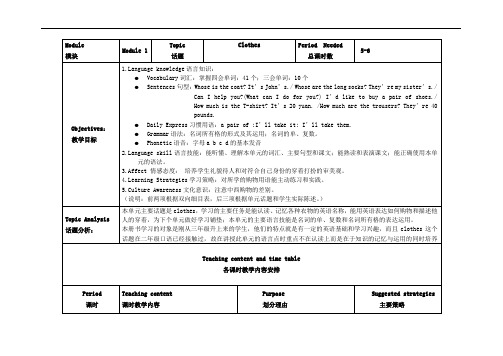
Scheme Work Module:1Unit: oneTarget for Grade : 4Task description:Task 1:Lesson PlanKey stage TargetsLanguage focusLanguage Skills: Listening, speaking, reading, writing Support MaterialProcedure:Step:1 Presentation of background knowledgeStep2: story telling with pictures and mimeStep3:Retelling story encouraging class partictipation Step4: Consolidation of vocabulary with various activities Step5: Class retelling of story, guided by teacherStep6: Acting out the storyStep7: Guided creative writingUnit 2 Shirts Dresses and TrousersWork with Language一、教学内容分析本Module的topic是clothes,主要任务是学习各种衣物的英语名称,学习如何用英语购买衣物以及为下一个Module描述人们的穿着作铺垫。
主要语法点是名词的单、复数形式及名词所有格的应用。
Unit 2 work with language主要是练习名词所有格用法。
重点句型是 Whose T-shirt is it? It’s Xiaoling’s.二、教学对象分析四年级学生经过三年的英语学习,有了一定的口语表达能力,但对语法知识的理解运用有一定难度。
在完成前面三课时的学习后,虽然他们已经学习了关于衣服和购买衣服的表达方法,但是对裤子与鞋子单复数表达仍然经常出错。
【广州市】PEP四年级英语上册全英教案全册

通册备课一、教学内容: BOOK 3本册书共六单元,课本内容共分六部分:Unite 1 My ClassroomUnite 2 My SchoolbagUnite 3 My FriendsUnite 4 My HomeUnite 5 What Would You Like?Unite 6 Meet My Family!二、教材分析为确保良好的教学效果,在教学新内容时要强调听准,辩清,观察,模仿,练习运用。
即:听音——仔细静听; 辩音——辨清发音;观察——注意观察; 模仿——认真模仿;练习——积极练习; 运用——实际运用;课堂练习A----活动手册它是本套教材教科书的主要组成部分,与课本同步进行。
B----单元练习每单元课后用一课时巩固前面内容。
录音带,投影片和教学挂图,音标卡片,字母卡片,教学图片。
这些辅助材料,均为配合课本的系列辅助材料,不仅可以帮助教师有效的进行教学,而且可以活跃课堂气氛,增加学生学习英语的兴趣。
三、教学目的1、对于有一年学习基础的学生要求进一步提高,加强儿童对英语的感性知识,激发他们学习英语的兴趣和培养能力,使学生敢于大胆开口说英语,在理解的基础上表演英语。
2、打下较好的语音,语调和书写基础。
3、养成良好的书写习惯,根据单词的拼写和发音规则认读和拼写单词。
四、重点难点:1、“四会”单词的教学。
2、每一课的会话的表演。
3、四会单词的拼写。
五一、教学内容1、本单元要求会听,说,认读的单词:window board light picture door floor classroom computerwall teacher’s desk fan what in the we have new go where2、本单元要求会听,说的单词和词组:many our seat near classmate cleanhave a look good idea all right good job3、帮助学生在掌握单词的基础上造出句子,编出对话,学以致用。
【广州市】人教版四年级英语上册教案全册

人教版四年级英语上册教案课题: Unit One My classroom第一课时导学稿教学目标:1.能听懂、会说:What's in the classroom? Aboard, two lights, many desks and chairs.并能在实际情景中运用。
2.能听、说、认读本课主要单词:classroom, window, door, picture, board, light, 3.能听懂并能按照指令做事情。
教学重点:学习What's in the classroom?及相关单词:classroom, window, door, picture, board, light。
教学难点:1. window一词注意w的发音,不要与v的发音混淆,教师在教学中应及时纠正。
2.在回答"What's in the classroom?"时,注意单词复数的读音。
教具准备:1.教材相配套的教学课件[Unit 1 Let's learn/A]2.教材相配套的教学录音带3.教师自制的单词卡4.一张画有教室的大图教学过程:(一)热身、复习(Warm-up / Revision)1.教师播放第一册Recycle 1单元中得"Chant and find"部分,学生跟着录音一起说。
2.教师出示与chant内容相符的图片,问:"What's in the picture?"让学生进行回答。
Picture一词由这里引出。
3.复习pencil, ruler, bag, book, pencil-case, sharpener, eraser, crayon, pen 等单词。
4.引导学生用以上单词做问答练习,如:What's in the bag? What's in thepencil-case ?5.在学生回答出问题后,教师可再追问:How many pencils/pens…?使学生能用复数进行回答。
新版广州版小学四年级英语上册教案全册
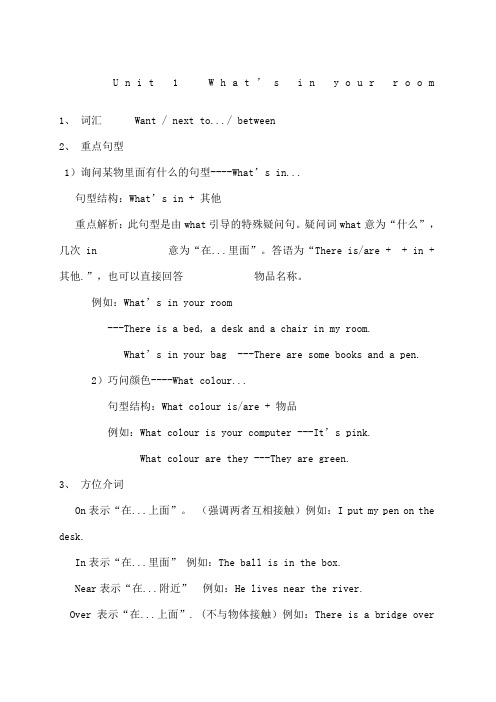
U n i t1W h a t’s i n y o u r r o o m1、词汇 Want / next to.../ between2、重点句型1)询问某物里面有什么的句型----What’s in...句型结构:What’s in + 其他重点解析:此句型是由what引导的特殊疑问句。
疑问词what意为“什么”,几次in 意为“在...里面”。
答语为“There is/are + + in + 其他.”,也可以直接回答物品名称。
例如:What’s in your room---There is a bed, a desk and a chair in my room.What’s in your bag ---There are some books and a pen.2)巧问颜色----What colour...句型结构:What colour is/are + 物品例如:What colour is your computer ---It’s pink.What colour are they ---They are green.3、方位介词On表示“在...上面”。
(强调两者互相接触)例如:I put my pen on the desk.In表示“在...里面” 例如:The ball is in the box.Near表示“在...附近” 例如:He lives near the river.Over表示“在...上面”. (不与物体接触)例如:There is a bridge overthe river.Under表示“在...下面” 例如:There is a pair of shoes under the bed. Behind表示“在...后面” 例如:There is a river behind the house.In front of表示“在...前面” 例如:There is a big tree in front of the house.Next to...在旁边例如:There is a bed next to the window.Between 在(两者)之间例如:There is a chair between the door and the window. 4、语法:be动词的用法和区别there be句型和have/has的用法区别一、Be动词Be动词:am、 is、 are口诀:我用am, 你用are, is用在他她它,复数全用are。
广州版英语四年级上册全册教案备课

广州版英语四年级上册全册教案备课Module 1 ClothesI. Objectives(目标)1. Language skill (Listening speaking reading writing)(1) know about clothes in English(2) can talk about clothes and ask the price of the clothes I want to buy.2. Language knowledge(1) Vocabulary:4 skills: shirt, blouse, dress, skirt, coat, pair, a pair of …., shoe, shorts, shop, can, help, I‘d like tobuy… much, how much, yuan, forth, them, twenty, thirty, fifty, eighty, hundred, T-shirt,sock, pound, whose3 skills: clothes, jacket, swea ter, trousers, jeans, assistant, shop assistant, take, I‘ll take it, sport,sport shoe, sir, bye, madamDrills(2) * Can I help you, sir / madam?* I‘d like to buy a pair of shoes.* How much is the T-shirt?* It‘s twenty yuan.* How much are the trousers?They‘re forty pounds.* Whose is the coat?It‘s John‘s.* Whose are the long socks?They‘re my sister‘s.(3) sub-topic:Unit 1: Buying clothesUnit 2: Different clothesUnit 3: Development3. Affect(1) To give pupils chances to share their knowledge.(2) To increase pupils‘ confidence & self-esteem(3) To provide challenges(4) To have fun(5) To develop cultureal awareness(6) To open the pupils‘ minds(7) To promote imagination4. Learning Strategy(1) Cognitive strategy(2) Regulating strategy(3) Communicative resource strategy5. Cultural Consciousness(1) The Eskimo woman wears her fur coat in winter in order to keep warm.(2) The Japanese woman wears her kimono at ceremonies because it‘s traditional.(3) The African woman wears her grass skirt when she is dancing. This is because it‘s traditionaland it keeps her cool.II. focal points:1.Can I help you sir / madam?2.I‘d like to….3.How much is / are…?It‘s / They‘re…4.Whose is / are…?III. Difficult points1.U sage of ―a pair of ….‖2.Practice in numerals.IV. Schedule: 8 long-periodsV. Materials: Textbook, Activity book, Tapes, Teacher‘s book, word cards.Unit 1 Buying ClothesI. Subjects1. vocabulary:can, help, buy, much, yuan, dress (4 skills)shop assistant, clothes, take (3 skills)2. Can I help you? I‘d like to buy….How much is it? It‘s….3. Culture: ―yuan‖——外来语,单复同形II. Focal and difficult pointsCan I help you? I‘d like to….How much is it? It‘s…I‘ll take itIII. Processes1. Leading inA. Review numeralsTen, twenty… ninety →ninety yuan (show) ―yuan‖ 外来语,单复同形B. P1T: Guess! Which one is worth 90 yuan?Yes, the dress. (教dress pl dresses)2. PresentationA. P2 T: Now, the woman is shopping at the shop.→T分饰两角,重复对话两次配合动作让生了解对话。
新版广州小学四年级上册英语教案5篇2022
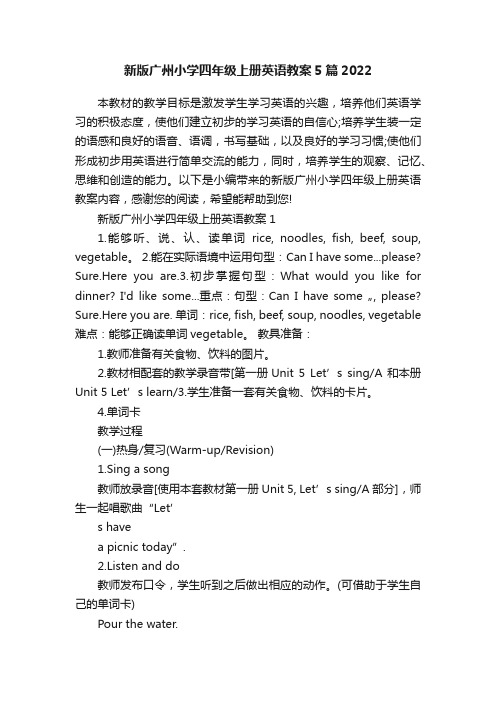
新版广州小学四年级上册英语教案5篇2022本教材的教学目标是激发学生学习英语的兴趣,培养他们英语学习的积极态度,使他们建立初步的学习英语的自信心;培养学生装一定的语感和良好的语音、语调,书写基础,以及良好的学习习惯;使他们形成初步用英语进行简单交流的能力,同时,培养学生的观察、记忆、思维和创造的能力。
以下是小编带来的新版广州小学四年级上册英语教案内容,感谢您的阅读,希望能帮助到您!新版广州小学四年级上册英语教案11.能够听、说、认、读单词rice, noodles, fish, beef, soup, vegetable。
2.能在实际语境中运用句型:Can I have some...please? Sure.Here you are.3.初步掌握句型:What would you like for dinner? I'd like some...重点:句型:Can I have some …, please? Sure.Here you are. 单词:rice, fish, beef, soup, noodles, vegetable 难点:能够正确读单词vegetable。
教具准备:1.教师准备有关食物、饮料的图片。
2.教材相配套的教学录音带[第一册Unit 5 Let’s sing/A 和本册Unit 5 Let’s learn/3.学生准备一套有关食物、饮料的卡片。
4.单词卡教学过程(一)热身/复习(Warm-up/Revision)1.Sing a song教师放录音[使用本套教材第一册Unit 5, Let’s sing/A部分],师生一起唱歌曲“Let’s havea picnic today”.2.Listen and do教师发布口令,学生听到之后做出相应的动作。
(可借助于学生自己的单词卡)Pour the water.Smell the coffee.Taste the tea.Show me the milk.Drink the juice.Cut the bread.Make the cake.Eat the hot dog.Show me the hamburger.Smell the chicken.Make the cake.Pa me the French fries.(二)呈现新课 (Presentation)1.教师出示Let’s learn部分的挂图,让学生说出图上食物和饮料的名称。
【广州市】新版PEP英语四年级上教学设计(全册)
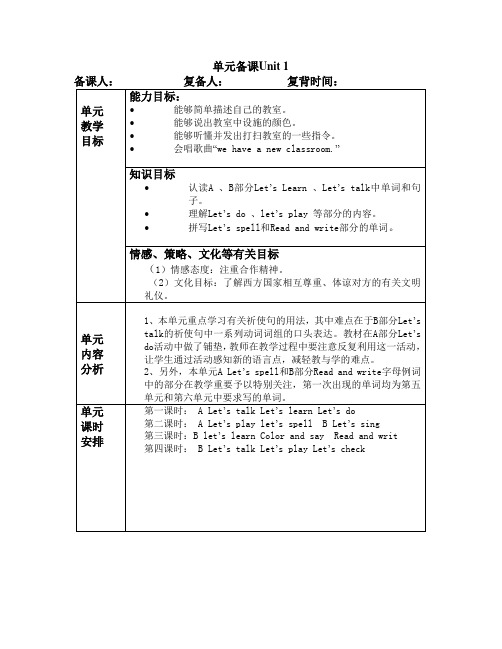
课题Unit1 My classroom 第一课时2. 教师把一张画有教室的大图贴到黑板上,说:This isa classroom. What’s in the classroom? (让学生先熟悉一下对话情景。
)3.学生听懂后,教师可先试着让学生回答,能说出英文的学生给与表扬(desk, chair, picture都已学过),也可让学生用中文回答。
4.展示有关classroom的内容,教读单词。
5.让学生观看本部分的教学课件2遍。
6.让学生看着课件的画面回答:What’s in the classroom?A board, two lights, many desks and chairs…当学生只回答出 board, light, desks and chairs 时,教师进一步再问:How many?引导学生说出:A board 或One board. Two lights. 教师可以直接把many一词告诉学生。
7.教师分别指着黑板,灯,桌子和椅子让学生说出单词。
8.教师在学生学习了对话的基础上,扩充词汇量:There are many things in the classroom. What are they?9.让学生观看教学课件,学习其它单词。
可从已学的单词过渡到新单词。
10.教师指着教室中的相关事物问学生:What’s this?让学生回答。
11.教师出示单词卡,让学生进行认读。
12.看黑板上所贴的单词卡,读出单词。
13.从单词过渡到词组,如 door,领读door,door,open the door.以下单词也是,这样从单词到词组,过渡自然,let’s do 节奏较强,在欢乐的节奏中结束课程。
(三)家庭作业(Homework)练习新学习的单词读音以及let’s talk课文。
板书设计:教学反思:课题Unit1 My classroom 第二课时课题Unit1 My classroom 第三课时分别点击以上事物,通过视听使学生更有效地记忆单词。
广州版英语四年级上册教案全册

SWE四年级(上)教案Module 1 ClothesUnit 1 Buying ClothesUnit 2 Different ClothesUnit 3 DevelopmentModule 2 PeopleUnit 4 FriendsUnit 6 DevelopmentUnit 5 Our Heroes And HeroinesModule 3 OccupationsUnit 7 Our Future JobsUnit 8 My family members’ jobsUnit 9 DevelopmentModule 4 People Who Help UsUnit 10 The New NeighboursUnit 11 They Can Help UsModule 5 TimeUnit 13 Our ArrangementUnit 14 Time to go to schoolUnit 15 DevelopmentModule 6 Days of the weekU16 Games we playRevision ⅠⅡⅢLong-Term ObjectivesSuccess with English aims to help pupils to achieve the following objectives:●To enjoy learning English;●To be motivated to learn English;●To become independent learners and users of English;●To want to be able to continue learning English after the course;●To become accurate users of English;●To become fluent users of English;●To become appropriate users of English;●To become effective users of English;●To become effective listeners of English;●To become effective speakers of English;●To become effective writers of English.Module 1 ClothesI. Objectives(目标)1. Language skill (Listening speaking reading writing)(1) know about clothes in English(2) can talk about clothes and ask the price of the clothes I want to buy.2. Language knowledge(1) Vocabulary:4 skills: shirt, blouse, dress, skirt, coat, pair, a pair of …., shoe, shorts, shop, can, help, I’d like tobuy… much, how much, yuan, forth, them, twenty, thirty, fifty, eighty, hundred, T-shirt,sock, pound, whose3 skills: clothes, jacket, sweater, trousers, jeans, assistant, shop assistant, take, I’ll take it, sport,sport shoe, sir, bye, madamDrills(2) * Can I help you, sir / madam?* I’d like to buy a pair of shoes.* How much is the T-shirt?* It’s twenty yuan.* How much are the trousers?They’re forty pounds.* Whose is the coat?It’s John’s.* Whose are the long socks?They’re my sister’s.(3) sub-topic:Unit 1: Buying clothesUnit 2: Different clothesUnit 3: Development3. Affect(1) To give pupils chances to share their knowledge.(2) To increase pupils’ confidence & self-esteem(3) To provide challenges(4) To have fun(5) To develop cultureal awareness(6) To open the pupils’ minds(7) To promote imagination4. Learning Strategy(1) Cognitive strategy(2) Regulating strategy(3) Communicative resource strategy5. Cultural Consciousness(1) The Eskimo woman wears her fur coat in winter in order to keep warm.(2) The Japanese woman wears her kimono at ceremonies because it’s traditional.(3) The African woman wears her grass skirt when she is dancing. This is because it’s traditionaland it keeps her cool.II. focal points:1.Can I help you sir / madam?2.I’d like to….3.How much is / are…?It’s / They’re…4.Whose is / are…?III. Difficult pointsage of “a pair of ….”2.Practice in numerals.IV. Schedule: 8 long-periodsV. Materials: Textbook, Activity book, Tapes, Teacher’s book, word cards.Unit 1 Buying ClothesI. Subjects1. vocabulary:can, help, buy, much, yuan, dress (4 skills)shop assistant, clothes, take (3 skills)2. Can I help you? I’d like to buy….How much is it? It’s….3. Culture: “yuan”——外来语,单复同形II. Focal and difficult pointsCan I help you? I’d like to….How much is it? It’s…I’ll take itIII. Processes1. Leading inA. Review numeralsTen, twenty… ninety →ninety yuan (show) “yuan” 外来语,单复同形B. P1T: Guess! Which one is worth 90 yuan?Yes, the dress. (教dress pl dresses)2. PresentationA. P2 T: Now, the woman is shopping at the shop.→T分饰两角,重复对话两次配合动作让生了解对话。
广州版小学英语四年级上册全册教案

广州版小学英语四年级上册全册教案目录MODULE1 CLOTHES《Unit1 Blouses and Jeans》 (2)MODULE1 CLOTHES《Unit2 Shirts, Dresses and Trousers》 (5)MODULE1 CLOTHES《Unit3 Let’s Go Further》 (7)MODULE2 PEOPLE《Unit4 Friends》 (11)MODULE2 PEOPLE《Unit5 Our Heroes and Heroines》 (15)MODULE3 OCCUPATIONS《Unit7 Our Future Jobs》 (19)MODULE3 OCCUPATIONS《Unit8 My Parents’Jobs》 (24)MODULE4 PEOPLE WHO HELP US《Unit10 My New Neighbours》 (30)MODULE4 PEOPLE WHO HELP US《Unit11 The Fireman Can Help》 (33)MODULE5 TIME《Unit13 Time to Eat》 (40)MODULE5 TIME《Unit14 Time for School》 (45)MODULE6 DAYS OF THE WEEK《Unit 16 Games We Play》 (50)MODULE1 CLOTHES《Unit1 Blouses and Jeans》1教学目标1、知识目标:①、能够听说认读单词: child, draw, bedroom, nex t, next to, window, door, computer, pink,flower,map,between, wall; ②、能熟练运用句子:What’s in your bedroom?There is a….../There are …..in/on/between..and…/next to……2、技能目标:能用What’s in your bedroom?提问和用There is a….../There are …..in/on/between..and…/next to……描述房间里有的物品及其位置;能运用I want you to draw….表达自己的愿意3、情感与态度目标:培养学生要关心和爱护自己的房间。
(完整)四年级英语上册全册教案新版广州版,推荐文档
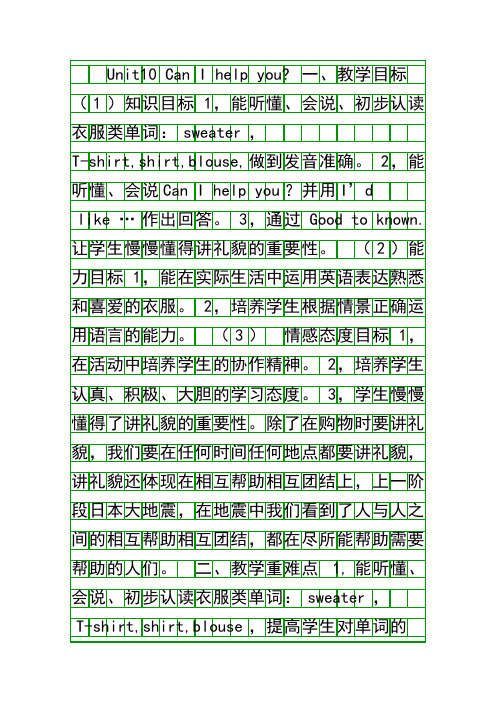
【广州市】新人教版四年级上册英语教案全册

Unit One My classroom教学目标与要求:1、能听懂、会说:What's in the classroom? Let’s go and see One blackboard, one TV, many desks and chairs…以及Where is it? It’s near the window. Let’s clean the classroom .OK .Let me clean the…Let me help you.并能在实际情景中运用。
2.能听、说、认读本课主要单词:classroom, window, door, picture, blackboard , light,computer, teacher's desk, fan, wall, floor。
A部分第一课时一、教学内容与分析1、Let’s talk本部分主要是会话学习。
通过Sarah与张鹏去看新教室的情景,让学生感知教室里有什么,什么东西在哪里的语义及语用情境。
2、Let’s play本部分让学生在游戏活动中熟练运用所学问句Where is it及回答。
二、教学步骤【一】热身(Warm-up)师生自由会话进入课堂。
【二】新课展示(Presentation)1、Where is…?话轮的呈现与操练(1)师生利用教师中的文具物品进行问答。
教师出示一本新书,提问:What’s this?并将该物品放在课桌或椅子的不同位置,再提问:Where is it?学生根据实际所见逐一回答。
教师接下来将新书放在桌子上的一个铅笔盒或一张图片旁边,教学near the pencil box/picture,及时板书重点句子和词汇。
(2)捉迷藏(Hide and seek)游戏教师将一只新钢笔藏起来,提问Where is my pen?学生猜测位置,最后教师出示钢笔并揭示答案。
学生根据教师的示范,两人一组进行游戏。
【精品资料】广州版小学英语四年级上册全册教案(word版,51页)
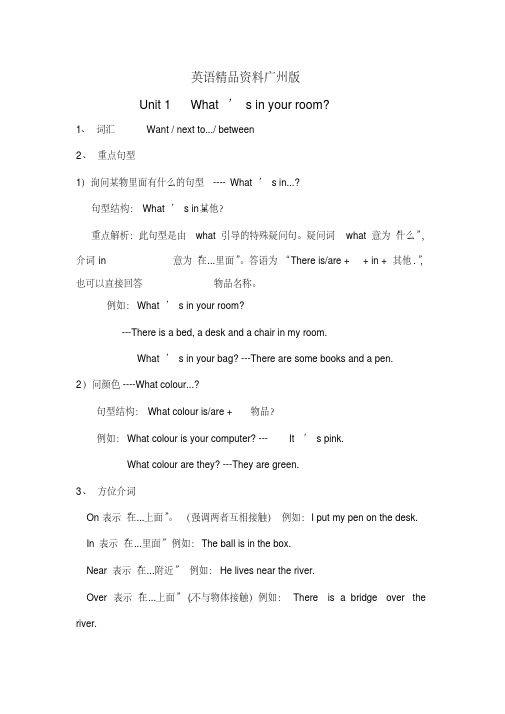
英语精品资料广州版Unit 1 What’s in your room?1、词汇Want / next to.../ between2、重点句型1)询问某物里面有什么的句型----What’s in...?句型结构:What’s in + 其他?重点解析:此句型是由what引导的特殊疑问句。
疑问词what意为“什么”,介词in 意为“在...里面”。
答语为“There is/are + + in + 其他.”,也可以直接回答物品名称。
例如:What’s in your room?---There is a bed, a desk and a chair in my room.What’s in your bag? ---There are some books and a pen.2)问颜色----What colour...?句型结构:What colour is/are + 物品?例如:What colour is your computer? ---It’s pink.What colour are they? ---They are green.3、方位介词On表示“在...上面”。
(强调两者互相接触)例如:I put my pen on the desk.In表示“在...里面” 例如:The ball is in the box.Near表示“在...附近” 例如:He lives near the river.Over表示“在...上面”. (不与物体接触)例如:There is a bridge over the river.Under表示“在...下面” 例如:There is a pair of shoes under the bed.Behind表示“在...后面” 例如:There is a river behind the house.In front of表示“在...前面” 例如:There is a big tree in front of the house.Next to...在旁边例如:There is a bed next to the window.Between 在(两者)之间例如:There is a chair between the door and the window. 4、语法:be动词的用法和区别there be句型和have/has的用法区别一、Be动词Be动词:am、is、are口诀:我用am, 你用are, is用在他她它,复数全用are。
- 1、下载文档前请自行甄别文档内容的完整性,平台不提供额外的编辑、内容补充、找答案等附加服务。
- 2、"仅部分预览"的文档,不可在线预览部分如存在完整性等问题,可反馈申请退款(可完整预览的文档不适用该条件!)。
- 3、如文档侵犯您的权益,请联系客服反馈,我们会尽快为您处理(人工客服工作时间:9:00-18:30)。
四年级英语上册全册教案新版广州版-CAL-FENGHAI-(2020YEAR-YICAI)_JINGBIAN四年级英语上册全册教案(新版广州版)Unit10 Can I help you?一、教学目标(1)知识目标1,能听懂、会说、初步认读衣服类单词:sweater,T-blouse,做到发音准确。
2,能听懂、会说Can I help you?并用I’dlike …作出回答。
3,通过Good to known. 让学生慢慢懂得讲礼貌的重要性。
(2)能力目标1,能在实际生活中运用英语表达熟悉和喜爱的衣服。
2,培养学生根据情景正确运用语言的能力。
(3)情感态度目标1,在活动中培养学生的协作精神。
2,培养学生认真、积极、大胆的学习态度。
3,学生慢慢懂得了讲礼貌的重要性。
除了在购物时要讲礼貌,我们要在任何时间任何地点都要讲礼貌,讲礼貌还体现在相互帮助相互团结上,上一阶段日本大地震,在地震中我们看到了人与人之间的相互帮助相互团结,都在尽所能帮助需要帮助的人们。
二、教学重难点1,能听懂、会说、初步认读衣服类单词:sweater,T-blouse,提高学生对单词的听、说、认、读能力。
2,听懂、会说Can I help you?并用I’dlike …作出回答。
通过活动复习巩固本单元的重点句型,让学生能灵活的运用所学的句型进话。
引导学生用完整的英语句子来表达自己的观点,提高学生对句子的组织能力和运用语言的能力,以及对知识的拓展能力。
三、课前准备教材,练习纸,水果类、玩具类以及衣服类的图片单词卡片,PPT课件,网络等。
四、教学步骤: Warm-up and review(1)GreetingT: Good morning ,boys and girls!S: Good morning,Miss Xu!T(教师边说边做动作):In class,we should do eye,S:look;T:ear, S:listen;T:mouth, S:say(2)Ask and answT:Look awords:how and what.Now I’ll ask you some quT:How are youS:I’ank you.T:What do you likeS1:I like applT:What can you seeS2:I can see a pencil.(3)Count numbT:Let’scouumbwelv:One,two,…twelve.T:Ok,well done.Tlet’s see what’s the numberS:Three.(课件中通过快闪方式呈现以下数字7,9,5)2: Presentation and pra(1)呈现王兵生日,引入主题。
1,T:It’s five.WangBing is five years old.First let’s guS:(2)FruT:What can you seeS1:I caur mang中次环节有5张桌子,分别放了不同数量的水果,另外分别是five bananas,eight peaapples,seven orangT:What can you seeS:I cave bananas.T: What do you likeS:I like bananas.2, T:What do you likeS:I like pearsT:I like peaI’d like a pear.“教授新句型:I’d like a/an …根据水果类单词,运用新句型造句。
T:(教师把营业员卡片贴在胸口)Now I’m a shop assistant.Welan I help youS1:I’d like a…课件中有5样水果,分别是:apple,mango,banana,pear,peach,让学生任意选择。
S:I’d like a…T:TI want to buy a banana.Who can ask meS2:Can I help youT:I’d like a banana.教授新句型:Can I help you X KbWa呈现:A:CanI help youB:I’d like a/an …(设计意图:通过小组操练的形式来培养同学们大胆开口说英语的好习惯,培养了同学们的口头表达能力。
)(3)Tlay a game:MagT:Well done.We’ve boughta luit for WangBing.Tlet’s gFirst let’s play a game,look carefully,and guess what is itT:What’s thisS:It’s a yo-中有4样玩具,分别是:yo-yo,jeep,doll,tra游戏规则:如果正确了,说明你们很棒哦!你们将为你们小组赢得一颗星。
2,T(教师手拿实物yo-yo) :There are mawhat happened Yo-g.Where’s my yo-yoOh,it’and.Whowant to buy Can I help youS1:I’d like a yo-T:Here you a:Thank youWa呈现:A:Can I help youB:I’d like a/an …A: Here you aB: Thank you.根据jeep,doll,train这几个单词,运用上面的句型造句。
4,T:TI want to bug for WangBing.Who can ask meS1: Can I help youT: I’d like a ja出示单词mango,根据单词中a 的发音,让学生试着读出新单词jacket。
ay a chant T:Let’s say a chant,lu read togHelp, help, can I help youI’d, I’d, I’d like a jaHere you aThank you. Thank you. Thank you.S:(学生齐读)T:I read it again.(歌谣中划线部分发生了改变,变成了a dress,教授新单词dress)6,T:Oh,I’ve bo ught a jacket and a dWangBing.(4)ClT:These are all cllet’s glu see every cloth has a number.Wdo you wa课件中展示一个衣架,上面有4件衣服,分别标好序号,让学生自由选择,然后教授两个新单词:shirt,blouT:TbThe blougirls.2,Play a ga拼图游戏,游戏规则:把任意衣服分成几小块,然后点击后一步步拼成一件衣服,让学生猜是哪个单词,如果你能很快的认出是什么单词,请举手大声读出单词;如果你能很快说出来,你们小组将得到一颗星奖励,如果你能很快地拼读出这个单词,你们小组将得到两颗星。
加油哦!T:Try to guessS:It’’s a …3,Dx●Read and ma●Read and wWatch acaT:Very good.Tlet’s have a rest and watch a caanswer a quT:What would WangBing like to buyS:He would like a ja,Show time:超级模仿秀Tips:AaunciaaA:Can I help youB:I’d like a ja超级模仿秀规则:根据学生读句子的语音语调,评选出朗读英语好的学生,即该小组获得一颗星。
6,Listen andLet’s gg给学生一个场景,让学生操练购物用语。
(设计意图:让学生们在愉快的情景下,提高自己的英语口语表达能力。
)8,Good to knowThrouglass study,we learned a luth.Inaddlite wg at awe want alite.Polite ald in help eautual unity.There was the super earthquack happened in Japaar.In the earthquack wal mutual help,a ldicall and soldiers,and voluverythinguld to help the earthquack need help people.(设计意图:这个环节通过课件,向同学们呈现了今年日本大地震的场景,让学生们了解了讲礼貌的重要性,人与人之间的相互帮助以及都在尽所能帮助需要帮助的人们。
这些知识的了解对于学生来说是一种额外的收获,对所学知识拓展的同时,使学生获得了学习成功的喜悦感和自豪感,激发学生兴趣的同时也增强了学生学习英语的自信心。
实现小学环境教育在英语课中的渗透,培养学生的跨文化意识。
): HomewListen andread Part AB2wordbook.Unit 11 I want to be a paTeaching aims:1. 学会不同工作的英文表达方式。
2. 了解同学父母的工作。
3. 学会简单的介绍自己将来的理想。
Key words:teacher, nurse, enganager, alawyer, dll:1.What do you do I am a teaWhat ddoa tea What does he do He is an eng2. What do youwant to be I want to be a tea What dwant to be She wants to be a singIntroduction and lead-GreetingT:Good evening,cla:Good evening,Miss Wang. T:Before we take uw lesson,I want to play a small game with you .There are four paand, and I wg aboubs.So Iu can listen carefully and gub.Ok( 开始做游戏并复习有关工作方面的单词,自然的导入新课。
)2.ReviewT:Ok.Just now we knewbgame.As we all knoware so many jobal life ,I guu learned them when you wal, so can you tellds of jobsS1:Teacher. S2:D:LawT:Oh,you are greaday our new labout joblease turn to page 18 .Unit 4 I want to be an aFirst,look aAaures aboubxplaure 1 and uwhab" to audbure 1,and then talkabouure ,and use newwhat does she/he do"to aTduwask job2 PresentaWblackboard.What do you do I am a teaWhat ddoa teaWhat does he do He is an eng2.Gudat after youPair-wGivuawa2.Ask several groups to drill the quand answPresentaIntroduce my ideal job. I want to be a pa2.Audent what they want to be xplawand wblackboard.What do you want to be I want to be a teaWhat dwant to be She wants to be a singGroup-wAudents work in groups,four studagroup,interview your classmates what they want to b2veral groups to act ouversaummawords about jobs:teacher, nurse, enganager, alawyer, dll2:1.What do you do I am a teaWhat ddoa teaWhat does he do He is an eng 2.What do you want to be I want to be a tea What dwant to be She wants to be a singHomewake a survey about your classmates' dream jobs.2.Find ouways to ask jobbooks andIas much as possiblUnit12 What’ s your father’s job一、教学内容:B Look, read and learn.C Ask and answer二、教学目标:会询问他人的年龄: 句子: How old are you / is he/ sheI’ m / He’ s / She’ s ….2. 复习日常交际用语What’ s his/her job He’ s /She’ s a… 能听懂、会说、会读 What abs They’ re…能把本课句型用到恰当的情景中,根据情景进行自由会话。
